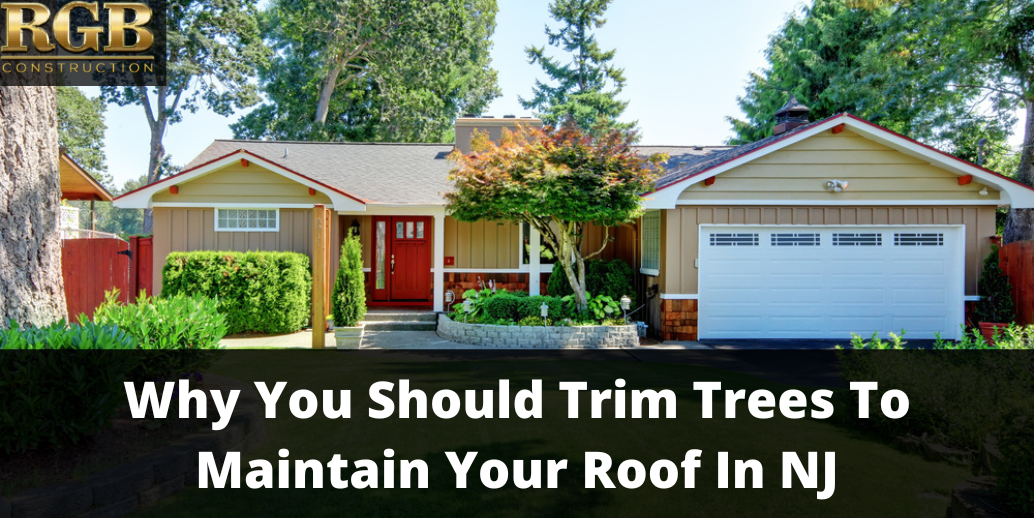Trees that are too close to your roof can drop debris that may slow rain movement and degrade your shingles. The limbs may rub against the shingles and wear away the granules. This is why you should make sure to trim trees close to your roof, and why, if you don’t trim them, you may need to look into the services of an NJ roofing contractor. In short, don’t neglect your trees! To avoid any amateur mistakes or injuries, you should consider looking into a professional tree trimmer. Otherwise, if you have damage to your roof from untrimmed trees, consult with a New Jersey roofing company like RGB Construction.
What Negative Effect Can Branches Touching My Roof Have?
Even thin branches resting against your roof may scratch and degrade shingles. As the wind blows the branches across your roof, they will scrape away and bang into shingles (possibly even puncturing them). The granules on the surface of shingles well adhere to the underlying asphalt of the shingle, but when branches scrape off the granules, the asphalt underneath is subjected to the sun’s UV rays. The shingle will quickly deteriorate until they no longer protect the waterproofing materials under them.
As well as physical damage to your shingles, branches that touch against your roof will provide a perfect route for wildlife to find its way into your roof or attic. Anything from squirrels to raccoons, to bugs (basically any animal that can climb, fly, or jump onto the roof) may find a way to access your roof, and even into your home from there. Your NJ roofing contractor can help prevent this by keeping your roof secure, as well as save you the trouble of coming face-to-face with one of these wild invaders.
Can Trees Damage My Roof If They Aren’t Touching It?
Trees can ruin your roof in a number of ways, the most obvious of which includes falling onto it. Wind or precipitation may push the branches into your roof, and more powerful wind and rain will just increase the damage that comes from branches slamming against your roof. Branches can also break off and fall onto your roof, which will only be made worse the heavier or higher up the branches may be.
Some lesser-known hazards you may face are that some trees may drop debris that could harm your roof. Commonly, pine needles and leaves create dams in the valleys or clog the gutters, resulting in extensive water damage. You may end up calling your local New Jersey roofing company for a solution.
Besides this water-trapping effect, certain debris such as walnuts, pecans, chestnuts, and others may be large enough to do impact damage to your shingles, especially over time. Even the shade from these branches is enough to damage your roof, as the shade may prevent moisture from evaporating quickly, which could lead to mold or algae growth, which will soon turn into a much larger problem. Luckily your local NJ roofing company can help fix any issues caused, but trimming branches and tree upkeep may postpone or even prevent that from becoming necessary.
Tree Trimming Tips To Save Your Roof From Damage
The tips of a tree’s branches should be at least six feet from your roof, and if you are planting a new tree– depending on its size you may have to plant it up to 20 or 30 feet from your home. Your homeowner’s insurance policy may have specific language about how far trees can be from your home, so always be sure to check your policy. Insurance companies may refuse to cover damages if your trees are too close, or if a tree becomes diseased or droops onto your roof and steps aren’t taken to remedy the situation.
If you are planting new trees, young trees should be pruned to control their growth and prevent them from trending toward your home. For trees that are a safe distance away but pushing it, you should always be sure to trim branches and leaves and keep any debris clean and clear.
You should also know the signs of a diseased or unstable tree, and immediately cut down or otherwise remove the tree before it can fall onto your roof. (Always check with your city bylaws, as some species of tree are protected, and some trees may be legally protected from cutting by their size.)
You should always be careful with large trees near your home– keep your eye on them and maintain them regularly and you may be able to avoid any large or lasting damage to your roof.
What Should I Do If My Roof is Damaged by a Tree?
Accidents happen. The unforeseen can put you in a vulnerable position as a homeowner. If nature has seen it fit to damage your roof, or even if any of these issues above have caused any deterioration or other roofing issues, you should reach out to a New Jersey roofing company such as RGB Construction immediately, before the issue becomes worse.
Issues with your roof could seriously affect your home’s structure and may displace you from your home temporarily, or even permanently. You shouldn’t try and patch or fix this damage yourself and risk making it worse, hiring a trusted NJ roofing contractor will give you the peace of mind of knowing the job is done professionally and correctly.
Hopefully, you can avoid taking this drastic step, but if you find yourself in such a dire position, you should contact RGB Construction and have one of our professional NJ roofing contractors save your roof as soon as possible! Give us a call at 856-264-9093.







